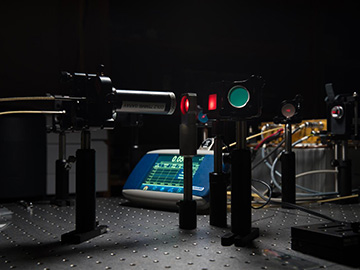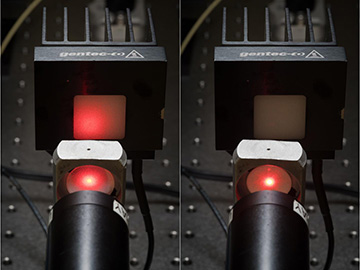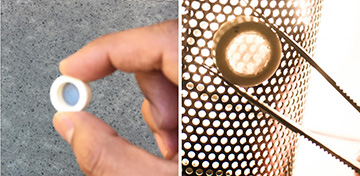
Using a 50-W ultrafast laser, a team of U.S. scientists was able to demonstrate a technique for reliable welding of ceramics—an industrial material heretofore very resistant to welding at room temperature. [Image: David Baillot/UC San Diego Jacobs School of Engineering]
In a very real sense, welded metal joints hold much of the industrial world together, and high-power lasers have revolutionized this type of welding over the past half century. Yet another important class of industrial materials—ceramics—stubbornly resist reliable welding using standard techniques, laser-driven or otherwise. That difficulty has limited the use of ceramics in some important spheres, such as consumer electronics and medical devices, where these tough workhorse materials arguably might be quite useful.
Now, researchers at two U.S. universities may have resolved this conundrum—by putting ultrafast pulsed lasers and nonlinear optics on the case (Science, doi: 10.1126/science.aaw6699). The team reports that its approach can produce reliable welds in ceramic materials that are strong enough to stand up to rigorous vacuum tests. The researchers believe that the work opens up prospects for using versatile ceramic materials in areas ranging from optoelectronics to biocompatible devices to microelectromechanical systems.
Strong but sensitive
The problems in welding ceramics stem, ironically, from the very thing that makes them so useful in industrial applications: their high temperature resistance. That means that welding ceramics together effectively requires putting the ceramic components into a furnace, and firing the whole thing up to very high temperatures for a long time. Such a roasting isn’t the friendliest thing in the world for ceramic assemblies that integrate, for example, delicate electronic components or polymers. It’s also an expensive and energy-intensive process that limits ceramic welds to only high-cost components.
Previous efforts have attempted to press lasers into service in joining ceramics together. But the powerful continuous-wave (CW) lasers used in many industrial welding operations, when applied to joining ceramics, can lead to thermal shock of the ceramic and cracks that ruin the material.
Inspiration from glass welds
The U.S. research team—led by OSA member Javier Garay of the University of California, San Diego (UCSD), and Guillermo Aguilar of the University of California, Riverside (UCR)—took a fresh look at the problem, from two angles: the characteristics of the ceramic material itself, and the use of relatively low-average-power, ultrafast pulsed lasers rather than high-power CW lasers to do the heavy lifting.
The team took as a starting point work in the past decade that has used ultrafast pulsed lasers to join certain glasses. In these welds, the laser focuses pulsed energy into the material at the weld point and stimulates nonlinear optical processes, such as multiphoton absorption, that lead to highly local heating and melting, without boosting the temperature of the surrounding material. The UCSD–UCR researchers reasoned that, by tweaking the optical transparency of ceramic materials, they might be able to pull off a similar trick in ceramic welds.
Tweaking the material—and the laser pulses

The team tested its technique on transparent (left) and traditional opaque (right) ceramics. [Image: David Baillot/UC San Diego Jacobs School of Engineering]
The team tried out the concept in two different sets of experiments. In one set, the researchers worked with a semitransparent ceramic, polycrystalline yttria-stabilized zirconia (YSZ), the transparency of which can be adjusted using simple thermal treatments. By tuning both the ceramic’s transparency and the characteristics of the laser pulse—pulse width, repetition rate and exposure time—they were able to weld a transparent cylindrical cap onto a cylindrical tube. The joint held up to tests under ultra-high vacuum (similar to those used to validate seals on electronic and optoelectronic devices).
In a second set of experiments, the UCSD–UCR engineers attempted a simple join of two segments of a ceramic tube, using conventional, diffuse samples of YSZ and another ceramic material, polycrystalline alumina. Here, rather than trying to make the opaque ceramic more transparent to optimize the interaction, the team’s approach worked by opening a small, carefully tuned gap between the materials to be joined, to allow focusing of pulsed energy at the interface.
Shear-strength tests revealed that the weld’s strength depended heavily on tuning the laser parameters. Co-team-leader Aguilar, in a press release accompanying the work, characterized the “sweet spot” for the ultrafast pulses as a 2-ps pulse width, a 1-MHz repetition rate and a “moderate” total number of pulses. “This maximized the melt diameter, minimized material ablation, and timed cooling just right for the best weld possible,” according to Aguilar.
Works with a 50-W laser

The team used the technique to join a transparent ceramic cap to a ceramic tube. The resulting component withstood vacuum tests at the same level used to validate seals on electronic and optoelectronic devices. [Image: Garay lab/UC San Diego Jacobs School of Engineering]
One obvious advantage of the new technique is that it can be used at room temperature, rather than in the superheated environs of a ceramic furnace. And, while they efficiently melt material at the weld point itself, the laser pulses are so sharply defined that they don’t boost the temperature of the rest of the workpiece.
Those advantages, the team notes, opens up the prospect of using ceramics in some places where their use hasn’t previously been considered—such as transparent, tough ceramics to package delicate optoelectronic components, lab-on-chip devices, biomedical implants and more. And the energy requirements are impressively low; the system operates using a pulsed laser with an average power of less than 50 W.
Thus far, the UCSD–UCR researchers have only demonstrated their system on two ceramic materials, and on workpieces of a few centimeters in size. But the authors write that the strategy “should be applicable to a wide range of other oxides, nitrides, and carbides,” especially as ultrafast lasers at a variety of wavelengths and power levels become increasingly available. And the team is now at work optimizing the process for larger-scale workpieces, complex geometries and other materials.
